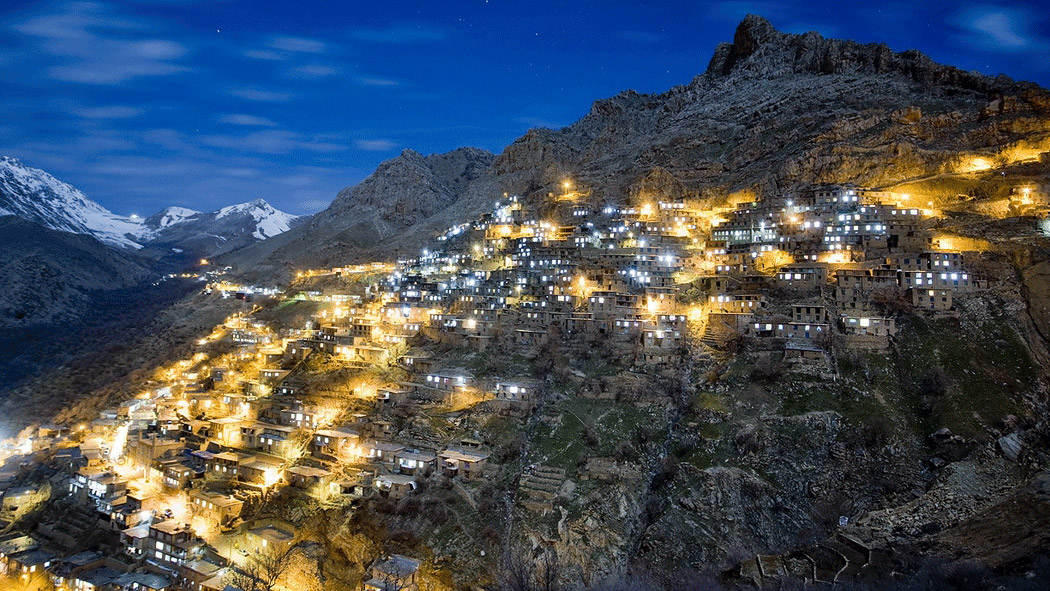Uraman and the cave of Karaftu in Kurdistan Province are to be inscribed on the world heritage list.
In spite of insufficient tourism infrastructure, Kurdistan is ready to welcome visitors during the Nowruz holidays, starting March 21. The results of a survey last year of travelers to the province show an increase in satisfaction with the services, said director general of Kurdistan provincial Iran Cultural Heritage, Handicrafts, and Tourism Organization (ICHHTO), Rasoul Eshtoudan.
He asserted that both Uraman and the cave of Karaftu, are among the major tourist attractions and with their listing approved, foreign tourists will also be added to the line of annual visitors to the sites, CHTN quoted him as saying.
A conference on “Uraman-ology” is to be held in Kurdistan during Nowruz, he added.
Uraman
Uraman or Uraman Takht (also known as Huraman, Avroman, Owraman, Owraman Shahr, and Shehr-e-Avroman) is a village in Uraman Takht rural district, Sarvabad county, Kurdistan Province.
It has been said to be a source of original Iranian and rich Kurdish art and culture from the days of yore. Thanks to the preservation of its heritage, architecture, and a unique traditional religious ceremony, namely ‘Pir Shalyar’, Uraman Takht village is known as one of Iran’s most impressive villages.
The name Huraman is derived from -hura and -man. Man means place or land; and Huraman is thought to mean the “Ahurayi land or the place of Ahura Mazda” or higher divine spirit. According to the people’s belief, Uraman used to be a big city and of great importance in the past, hence it was known as Takht (meaning throne) or the center of the government.
At an altitude of 1450 meters above the sea level, the village enjoys mild weather in spring and summer, and cold weather during fall and winter. Uraman is a vast and mountainous area of Zagros which includes the entire south of Kurdistan Province, and Uraman Takht village is a part of it.
The village is located on a steep slope facing the northern side of the Uramanat Mountain. Therefore just like Masuleh village, Gilan province, it has a dense and step-like residential area adding to its beauty and attractiveness. The roof of each house forms the yard of the upper one, and the walls are made without using any mortar, just by artistically putting pieces of stone on top of one another. The most frequently used materials in construction of buildings are stone and wood; and the wood is usually from walnut or plane trees.
The residents of the village are Sunni Muslims and speak in Urami or Hurami dialect of the Kurdish language. Most of Uraman Takht residents are farmers, gardeners, or raisers of livestock; while some of them work in the field of handicrafts. Among traditional arts and handicrafts of the people are various kinds of felt, cotton shoes, woolen rugs (called Jajim), wooden cutlery, windows, and doors. Just like the people of other villages of Kurdistan, residents of Uraman wear local Kurdish clothes, of bright and attractive colors and patterns.
Due to the tough climatic conditions, the customs and traditions of its people have remained pristine; the most significant of which is ‘Pir Shalyar’. It is a religious ceremony held on the last Wednesday and Thursday before mid-Bahman (early February) next to his mausoleum in Uraman Takht village. Pir Shalyar was a Zoroastrian priest and it is said to have embraced Islam later on.
The ceremony which according to some historians dates back to a thousand years ago, lasts for two weeks and is the wedding anniversary of a legendary ‘pir’ (an elderly respectable person), whose name was ‘Shahryar’ (or ‘Shalyar’ in Kurdish dialects), and has its roots in the ancient myths of the area.
Tourist attractions of Uraman are not limited to the afore-mentioned. This region is one of the most fascinating areas in natural attractions, some of which are the large and deep river of Sirvan, fruit gardens, numerous waterfalls and caves such as Quri Qal’e, the biggest water cave in the world and regarded as one of the most beautiful caves in Asia.
Cave of Karaftu
Karaftu is situated 64 km from Saqqez (and 12 km from the village of Kereftu). Strategically, this site connects the ancient road from Syria and Iraq, leading through Iran to Afghanistan, i.e. it is on the Silk Road. Throughout history, and even today, many caravans have passed through this road, endowing particular importance to this region. Many sites in the immediate surroundings of this rocky mountain have been found to be connected via various tunnels and corridors through the rocks.
These labyrinths date back to 300 B.C., and belong to the Ashkanid dynasty. There is a temple for Heracles (2000 years ago), and the name of this Greek god is carved on one of the walls of the third room, accompanied by a horse rider (hunting a deer) which is believed to illustrate Goudarz the Ashkanid king.
Various war triumphs are also illustrated, and believed to date back to the same historical era. The eminent Russian historian Tasit, claimed that the paintings illustrate the importance of this temple and is attributed to the victory of Ashkanid dynasty.
Entering the caves is arduous, as entrances are on the heights of the steep mountain. The corridors are also difficult to pass through, as the sizes were constructed for strategic purposes. Some passages maintain natural water wells, and many of the labyrinth-like corridors lead to important fireplaces (in the temple).
Investigations on the paintings have revealed that oil based colors have been used, and that the attached buildings in the various wings, indicate an annexed village to the temple.


